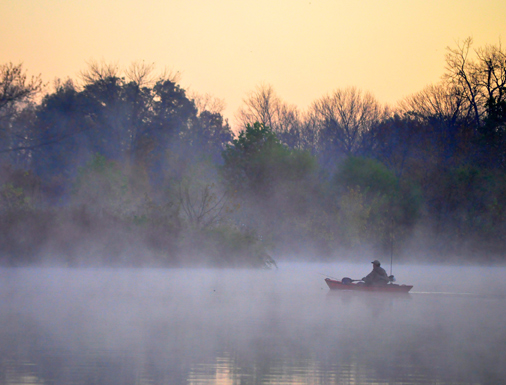By Art Lander Jr.

FRANKFORT, Ky. – Canoes, kayaks and float boats are quiet, light, maneuverable, environmentally friendly and can be launched almost anywhere. There’s a lot to like about paddle-powered fishing boats.
“Kentucky is blessed with a large number of small streams that offer excellent fishing during the summer months,” said Ryan Oster, federal aid coordinator for the fisheries division of the Kentucky Department of Fish and Wildlife Resources. “Many streams are lightly fished, and anglers will find that fish are aggressive because water in streams is often cooler.”
In fact, Kentucky has over 8,000 miles of streams that offer quality fisheries, many of which are tree-canopied waterways off the beaten path. Some small public lakes are also ideal for paddle-powered boats since the use of gasoline-powered motors is prohibited.
“The Department helps develop access to streams using boating access federal funding from the Sport Fish Restoration Act. Historically, boating access funds could only be used to develop access sites and related facilities that benefited boats with gasoline powered engines. Recently, the use of these funds has been expanded to include all boat types, including those without gasoline-powered engines such as canoes and kayaks,” said Oster. “Some of the streams we are looking at closely to develop access include the Green River, Licking River, Kentucky River and the Floyd’s Fork of the Salt River.”
Sport Fish Restoration funds come from excise taxes placed on the sale of fishing equipment and motor boat fuels. State fish and wildlife agencies that receive this funding are mandated to spend a minimum of 15 percent of their annual apportionment on boating access projects.
“Limited funds are available, but access for paddle-powered boats is a lot less costly to build and less land – usually one-half acre or less – is needed, compared to what it typically takes to build a boat ramp,” Oster explained.
Access for paddle-powered boats is typically a parking lot and an area where paddlers can drag their boats down to the water. On steep-sided banks, a slide is built, with steps down to the water.
Anglers are reminded that permission from the landowner is required to cross private land to access streams or lakes. Persons who fail to obtain permission may be cited for trespassing.
Sales of paddle-powered boats have increased in recent years, despite an industry downturn. While new power boat sales declined 10 percent in 2010, according to data released by the National Marine Manufacturers’ Association (NMMA), fishing kayaks, in particular, have become one of the fastest–growing segments of this small boat market.
These shallow draft boats first became popular in coastal areas, but anglers’ use of these boats on freshwater lakes and rivers has grown in popularity. The sit-on-top and the hybrid “open boat” designs seem to have the largest following among anglers. These styles offer a way to gain access to shallow creeks, remote wetlands, small lakes and ponds that are either off limits to big boats or too shallow for them to navigate.
From a practical standpoint, paddle-powered boats are a good value. Their purchase price and long-term operating costs are thousands of dollars less than a traditional sport fishing boat powered by an outboard motor, and rigged with an electric trolling motor, livewell, electronic depth finders and GPS.
A top-of-the-line kayak outfitted for fishing (rod holder, anchor, dry storage and pedal drive system) can be purchased for about $2,200, with some of the best boats on the market selling for less than $1,200.
Extras that paddlers will need to buy include a paddle, a life jacket, and roof rack is needed to transport the boat on top of a passenger car.
A pickup truck might be the ideal vehicle for transporting a fishing canoe, kayak or float boat. With the tailgate down, there’s plenty of room to carry a boat in an 8-foot truck bed. Using 1-inch ratchet straps is the most convenient and reliable way to tie down a boat to a roof rack or secure it in the bed of a pickup.
There are other expenses that simply don’t apply to paddle-powered boats such as boat registration fees, property taxes, fuel, and engine maintenance costs. In Kentucky and many other states, paddle-powered boats are exempt from registration.
Paddle-powered boats offer some health benefits, too. With all that paddling anglers work their arm muscles and burn some calories as well.
Outfitters across Kentucky rent kayaks and canoes for public use and give an angler and idea of how these boats perform. Try one of these boats this summer and enjoy green, affordable fishing.
Author Art Lander Jr. has been writing about the outdoors since the 1970s. He is a staff writer for Kentucky Afield Magazine.
-30-
The Kentucky Department of Fish and Wildlife Resources manages, regulates, enforces and promotes responsible use of all fish and wildlife species, their habitats, public wildlife areas and waterways for the benefit of those resources and for public enjoyment. Kentucky Fish and Wildlife is an agency of the Tourism, Arts and Heritage Cabinet. For more information on the department, visit our website at fw.ky.gov.


Be the first to comment